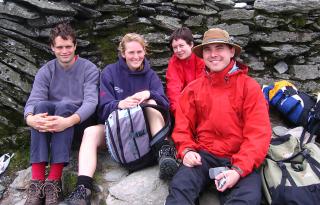The weekend in Lakeland was most enjoyable. We spent Saturday and Sunday walking, each time going around a horseshoe of peaks. Saturday, it was the Coniston horseshoe, starting with the Old Man. That day involved some enjoyable scrambling, a bit of actual rock climbing (for those who cared to try), and a brief nighttime rescue operation. Thankfully, those we set out to find met us on the road back from where we were heading to look for them. Sunday, we did the Kentmere Horseshoe, starting with Yoke.
The walking was atypical of the club for a couple of reasons. Firstly, I had never previously spent a day with them in which it did not rain significantly. Neither day of this trip involved any rain at all. Secondly, this was distinctly less strenuous than Snowdonia, which was distinctly less strenuous than Scotland. I rather enjoyed the drama of steep slopes and narrow, windy ridges during the previous two trips. Of course, there is something to be said for sheep-speckled tranquility as well.
In terms of company, this trip met the high expectations I had of the Walking Club. There is always a fascinating mixture of people from different fields – from theology to comparative literature to medicine – and they tend to get along in a very spontaneous way, even when they have not met before.
Photos and such to follow. For now, I need to get some sleep.


A good solar idea for a change. Algae based petroleum for 50$ US a barrel.
here’s the link http://www.greenfuelonline.com/news/algaefuel.pdf
Tristan,
Solar power is an excellent idea. All that we need to do is lower the cost per watt and deal with some storage issues. The fact that it has practical difficulties at the moment doesn’t detract from how it is the most intuitive system for energy generation. Barring fission, all our energy comes (indirectly) from the sun anyhow.
You need to look at this paper. It’s solar oil. What storage issues are there with oil? It goes in a barrel. Easy. And what’s required? Sequestered Co2, algae, and sunlight. Projected cost as low as 50$ a barrel. Could replace US’ entire oil supply with 36 thousand square kilometre facility in desert.
Tristan,
I will have a look at it. If it is economical, I am sure the people who came up with the idea will end up doing very well indeed.
GreenFuel went belly up, as described here.
Apparently, they were the “highest-profile (and well-funded) company working on algal biodiesel.”
According to Robert Rapier: “GreenFuel was the first high profile algal concern to go under, but they won’t be the last. I predict that none of them will be standing in just a few short years. Growing algae is trivial and can be done in water, and there is the allure. Turning into biodiesel is not technically very difficult. Doing it all economically is next to impossible. I have had one very prominent algae expert tell me that it will be at least 15 years before there are serious prospects for commercial viability – and that will require multiple large technical breakthroughs.”
http://www.youtube.com/watch?v=p0fbR-7Y6Xo
These treks are part of a grand British tradition; the right to walk over private land. This right is not unlimited. The route has to have been established by custom. Some of the paths were built by the Romans; others date back to “time immemorial”, a date established by legal convention to be the reign of Richard the Lionheart (1189-1199).